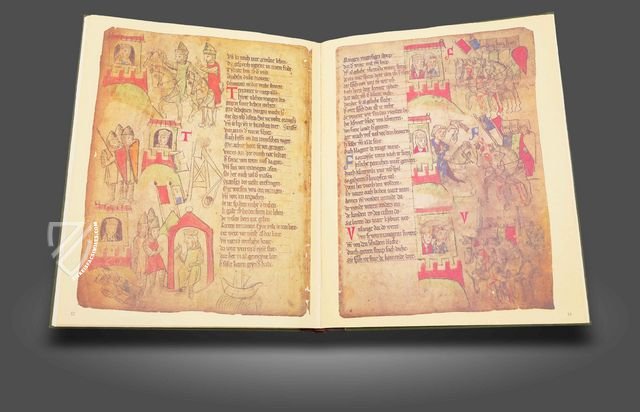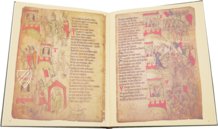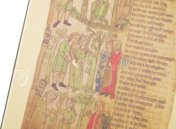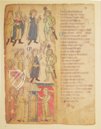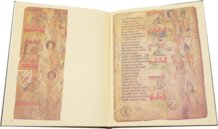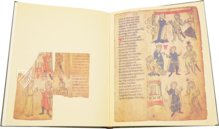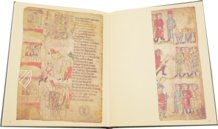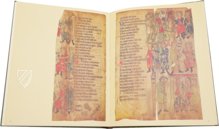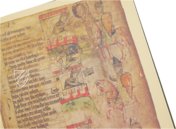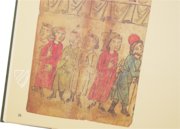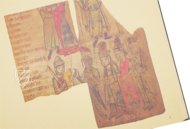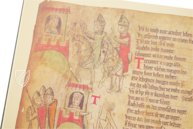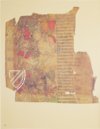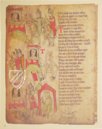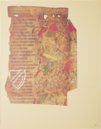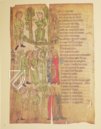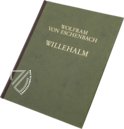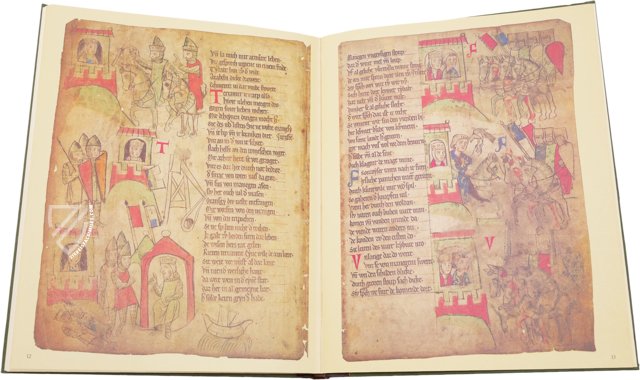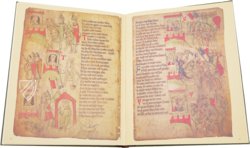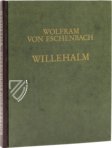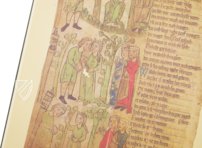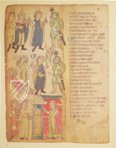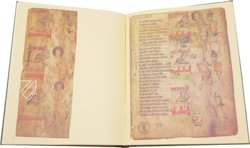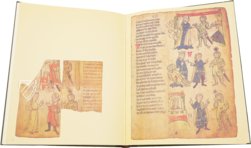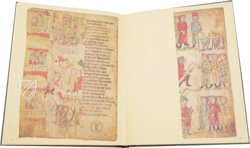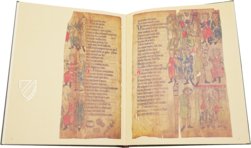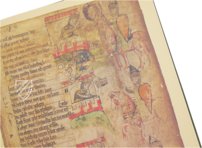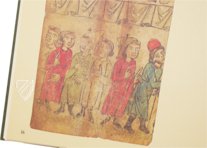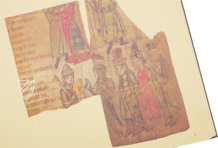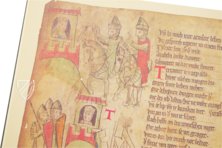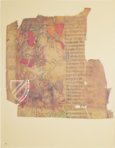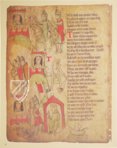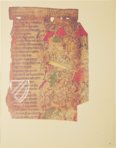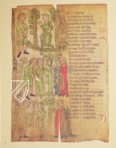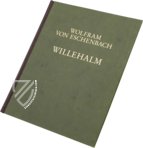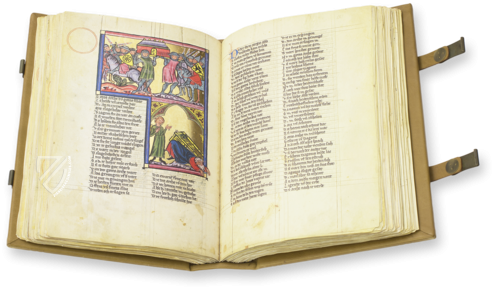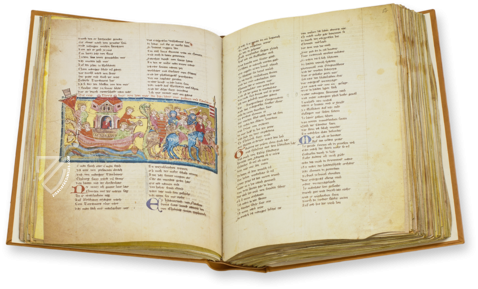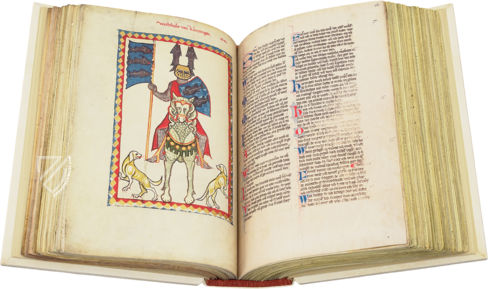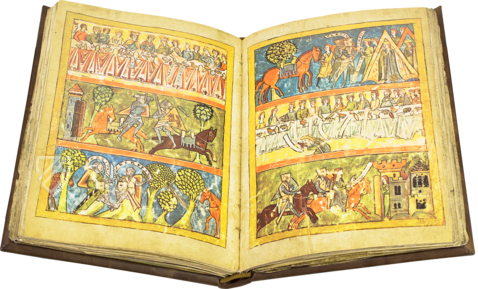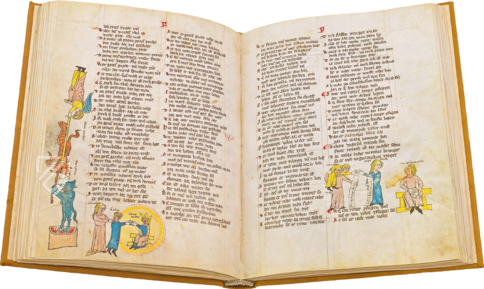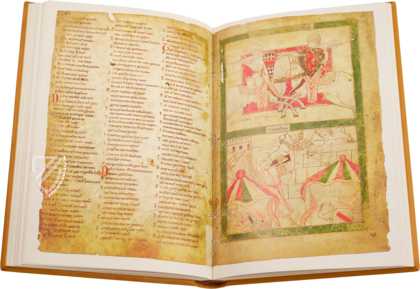Willehalm - Wolfram von Eschenbach
(1,000€ - 3,000€)
Wolfram von Eschenbach's epic poem Willehalm was one of the most popular heroic epics of the Middle Ages and is one of the most outstanding examples of high medieval courtly poetry. Created around 1270–75 in the area of Quedlinburg or Halberstadt, the so-called "great pictorial manuscript", which with originally no less than 1300 miniatures was "probably the most richly illuminated German manuscript of the Middle Ages", presents the chivalric stories of the poem to the reader in expressive images. The preserved fragments of this unique manuscript, now kept in Munich and Nuremberg, give an idea of the original splendor of the codex. Each leaf is adorned with three gold-decorated washed pen-and-ink drawings that complement the text. The protagonist Willehalm is highlighted throughout the narrative and expressive scenes by means of a golden star, which makes the picture program particularly catchy and comprehensible.
Willehalm - Wolfram von Eschenbach
The Willehalm epic by the Staufian poet Wolfram von Eschenbach is counted among the most preeminent examples of courtly poetry of the High Middle Ages. In the so-called “great pictorial manuscript,” originating around 1270–75 and originally featuring 1,300 illustrations, “it was probably the most richly illuminated German manuscript of the Middle Ages,” the text is visualized by expressive images. The fragments of the manuscript, housed today in Munich and Nuremberg, give an inkling of the original splendor of the codex.
A Fragment of Historical Value
The earliest illustrated codex about the knight Willehalm, which still exists in fragments today, originates from around 1270–75. This so-called “great pictorial manuscript” originally had 1,300 illustrations, making it “probably the most richly illuminated German manuscript of the Middle Ages.” The surviving fragments still speak to this brilliance today. The Bavarian State Library in Munich as well as the Germanisches Nationalmuseum in Nuremberg each possess a part of the fragments, eight in Munich and two in Nuremberg, respectively. The author of the epic was Wolfram von Eschenbach, the distinguished author of many Middle High German epics such as the Parzival, his most famous work, and the Minnelieder. Wolfram von Eschenbach composed the Willehalm in the years 1210–15, whereby he relied upon an unknown French source, which was owned by the Landgrave Hermann I of Thuringia. It is concerned with the story of Willehalm, Margrave of Provence, and Arabel or rather Gybure, the daughter of a Saracen King.
Text and Imagery in Peaceful Symbiosis
The great pictorial manuscript, the earliest illustrated Willehalm codex, originated from the region of Quedlinburg or Halberstadt in the years 127—75. The focus is on the images, which take up the majority of the page. Every page of the text is furnished with text and a corresponding illustration, whereby the text is contained respectively in a thin bracket on the outer margin with the image in the middle. Three pictorial illustrations are arranged one below the other on each page. The pictorial scenes mostly consist of groups of figures, sometimes with a background of architectural structures or trees and shrubbery. Various persons strongly act out gestures thereby: courtly ladies, armored knights, and common folk. The illustrator made the scenes easier to understand through a subtle trick: the protagonist Willehelm is always denoted with a golden star above his figure or on his shield, in order to distinguish him from the others. The painter employed luminous colors for the coloration of his pen and ink drawings, mostly red, yellow, green, and blue. The fragments of the manuscript, despite their fragmentariness, allow for a clear understanding of the great Middle High German Willehalm epic and the illumination of the 13th century.
Codicology
- Size / Format
- 20 pages / 32.0 × 25.0 cm
- Origin
- Germany
- Date
- Around 1270
- Epochs
- Style
- Genre
- Language
- Illustrations
- 60 colored and gold decorated pen and ink drawings
- Artist / School
- Wolfram von Eschenbach (1170–1220) (author)
Willehalm - Wolfram von Eschenbach
Wolfram von Eschenbach between the Queen and Willehalm
The center of the miniature is the narrator Wolfram, who points with his hands to the left and to the right, while facing Willehalm on the right side, marked by a star. Willehalm is worried about Princess Gyburg, which is indicated by the female head next to the star and which is the reason for his sorrowful attitude. In addition, there is probably also the shame of having pulled the hair of the arrogant queen in a very unchivalrous way, from which she is still hurt. The blue reference initial "M" indicates that it is the miniature to the verse beginning with the same initial in the accompanying text column.
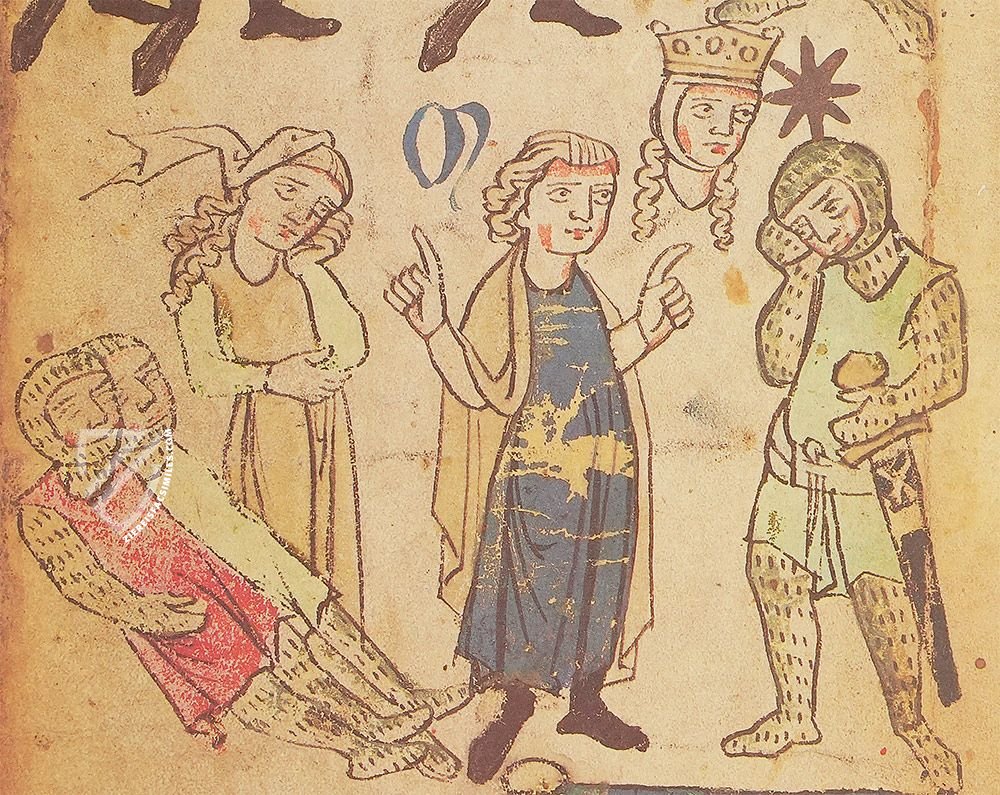
Willehalm - Wolfram von Eschenbach
Rennewart says goodbye to Alyze
On this page, Rennewart, the brave friend of Willehalm, takes leave of the beautiful princess Alyze, Willehalm's niece. She appears in the center of each of the three sections, accompanied by one or two women in the right margin. Rennewart approaches her virtuously respectfully from the left. He has placed his weapon at the left edge of the page.
Corresponding to the text, the trees locate the scene outdoors and also serve to visualize the closeness of the figures to each other. Thus Alyze is flanked by two trees at the top and bottom and therefore distanced from all the figures. However, in the center section, she kisses Rennewart goodbye. This physical intimacy is taken up by the new arrangement of the trees, which now enclose the couple.
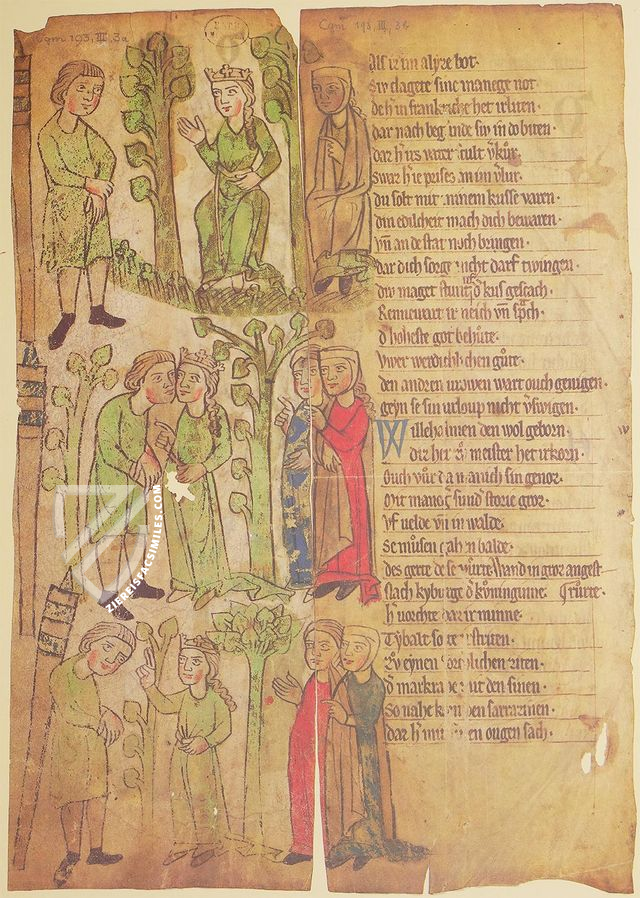
#1 Willehalm - Wolfram von Eschenbach
Language: German
(1,000€ - 3,000€)
- Treatises / Secular Books
- Apocalypses / Beatus
- Astronomy / Astrology
- Bestiaries
- Bibles / Gospels
- Chronicles / History / Law
- Geography / Maps
- Saints' Lives
- Islam / Oriental
- Judaism / Hebrew
- Single Leaf Collections
- Leonardo da Vinci
- Literature / Poetry
- Liturgical Manuscripts
- Medicine / Botany / Alchemy
- Music
- Mythology / Prophecies
- Psalters
- Other Religious Books
- Games / Hunting
- Private Devotion Books
- Other Genres
- Afghanistan
- Armenia
- Austria
- Belgium
- Belize
- Bosnia and Herzegovina
- China
- Colombia
- Costa Rica
- Croatia
- Cyprus
- Czech Republic
- Denmark
- Egypt
- El Salvador
- Ethiopia
- France
- Germany
- Greece
- Guatemala
- Honduras
- Hungary
- India
- Iran
- Iraq
- Israel
- Italy
- Japan
- Jordan
- Kazakhstan
- Kyrgyzstan
- Lebanon
- Liechtenstein
- Luxembourg
- Mexico
- Morocco
- Netherlands
- Palestine
- Panama
- Peru
- Poland
- Portugal
- Romania
- Russia
- Serbia
- Spain
- Sri Lanka
- Sweden
- Switzerland
- Syria
- Tajikistan
- Turkey
- Turkmenistan
- Ukraine
- United Kingdom
- United States
- Uzbekistan
- Vatican City
- A. Oosthoek, van Holkema & Warendorf
- Aboca Museum
- Ajuntament de Valencia
- Akademie Verlag
- Akademische Druck- u. Verlagsanstalt (ADEVA)
- Aldo Ausilio Editore - Bottega d’Erasmo
- Alecto Historical Editions
- Alkuin Verlag
- Almqvist & Wiksell
- Amilcare Pizzi
- Andreas & Andreas Verlagsbuchhandlung
- Archa 90
- Archiv Verlag
- Archivi Edizioni
- Arnold Verlag
- ARS
- Ars Magna
- ArtCodex
- AyN Ediciones
- Azimuth Editions
- Badenia Verlag
- Bärenreiter-Verlag
- Belser Verlag
- Belser Verlag / WK Wertkontor
- Benziger Verlag
- Bernardinum Wydawnictwo
- BiblioGemma
- Biblioteca Apostolica Vaticana (Vaticanstadt, Vaticanstadt)
- Bibliotheca Palatina Faksimile Verlag
- Bibliotheca Rara
- Boydell & Brewer
- Bramante Edizioni
- Bredius Genootschap
- Brepols Publishers
- British Library
- C. Weckesser
- Caixa Catalunya
- Canesi
- CAPSA, Ars Scriptoria
- Caratzas Brothers, Publishers
- Carus Verlag
- Casamassima Libri
- Centrum Cartographie Verlag GmbH
- Chavane Verlag
- Christian Brandstätter Verlag
- Circulo Cientifico
- Club Bibliófilo Versol
- Club du Livre
- CM Editores
- Collegium Graphicum
- Collezione Apocrifa Da Vinci
- Comissão Nacional para as Comemorações dos Descobrimentos Portugueses
- Coron Verlag
- Corvina
- CTHS
- D. S. Brewer
- Damon
- De Agostini/UTET
- De Nederlandsche Boekhandel
- De Schutter
- Deuschle & Stemmle
- Deutscher Verlag für Kunstwissenschaft
- DIAMM
- Droz
- E. Schreiber Graphische Kunstanstalten
- Ediciones Boreal
- Ediciones Grial
- Ediclube
- Edições Inapa
- Edilan
- Editalia
- Edition Deuschle
- Edition Georg Popp
- Edition Leipzig
- Edition Libri Illustri
- Editiones Reales Sitios S. L.
- Éditions de l'Oiseau Lyre
- Editions Medicina Rara
- Editorial Casariego
- Editorial Mintzoa
- Editrice Antenore
- Editrice Velar
- Edizioni Edison
- Egeria, S.L.
- Eikon Editores
- Electa
- Emery Walker Limited
- Enciclopèdia Catalana
- Eos-Verlag
- Ephesus Publishing
- Ernst Battenberg
- Eugrammia Press
- Extraordinary Editions
- Fackelverlag
- Facsimila Art & Edition
- Facsimile Editions Ltd.
- Facsimilia Art & Edition Ebert KG
- Faksimile Verlag
- Feuermann Verlag
- Folger Shakespeare Library
- Franco Cosimo Panini Editore
- Friedrich Wittig Verlag
- Fundación Hullera Vasco-Leonesa
- G. Braziller
- Gabriele Mazzotta Editore
- Gebr. Mann Verlag
- Gesellschaft für graphische Industrie
- Getty Research Institute
- Giovanni Domenico de Rossi
- Giunti Editore
- Graffiti
- Grafica European Center of Fine Arts
- Guido Pressler
- Guillermo Blazquez
- Gustav Kiepenheuer
- H. N. Abrams
- Harrassowitz
- Harvard University Press
- Helikon
- Hendrickson Publishers
- Henning Oppermann
- Herder Verlag
- Hes & De Graaf Publishers
- Hoepli
- Holbein-Verlag
- Houghton Library
- Hugo Schmidt Verlag
- Idion Verlag
- Il Bulino, edizioni d'arte
- ILte
- Imago
- Insel Verlag
- Insel-Verlag Anton Kippenberger
- Instituto de Estudios Altoaragoneses
- Instituto Nacional de Antropología e Historia
- Introligatornia Budnik Jerzy
- Istituto dell'Enciclopedia Italiana - Treccani
- Istituto Ellenico di Studi Bizantini e Postbizantini
- Istituto Geografico De Agostini
- Istituto Poligrafico e Zecca dello Stato
- Italarte Art Establishments
- Jan Thorbecke Verlag
- Johnson Reprint Corporation
- Josef Stocker
- Josef Stocker-Schmid
- Jugoslavija
- Karl W. Hiersemann
- Kasper Straube
- Kaydeda Ediciones
- Kindler Verlag / Coron Verlag
- Kodansha International Ltd.
- Konrad Kölbl Verlag
- Kurt Wolff Verlag
- La Liberia dello Stato
- La Linea Editrice
- La Meta Editore
- Lambert Schneider
- Landeskreditbank Baden-Württemberg
- Leo S. Olschki
- Les Incunables
- Liber Artis
- Library of Congress
- Libreria Musicale Italiana
- Lichtdruck
- Lito Immagine Editore
- Lumen Artis
- Lund Humphries
- M. Moleiro Editor
- Maison des Sciences de l'homme et de la société de Poitiers
- Manuscriptum
- Martinus Nijhoff
- Maruzen-Yushodo Co. Ltd.
- MASA
- Massada Publishers
- McGraw-Hill
- Metropolitan Museum of Art
- Militos
- Millennium Liber
- Müller & Schindler
- Nahar - Stavit
- Nahar and Steimatzky
- National Library of Wales
- Neri Pozza
- Nova Charta
- Oceanum Verlag
- Odeon
- Orbis Mediaevalis
- Orbis Pictus
- Österreichische Staatsdruckerei
- Oxford University Press
- Pageant Books
- Parzellers Buchverlag
- Patrimonio Ediciones
- Pattloch Verlag
- PIAF
- Pieper Verlag
- Plon-Nourrit et cie
- Poligrafiche Bolis
- Presses Universitaires de Strasbourg
- Prestel Verlag
- Princeton University Press
- Prisma Verlag
- Priuli & Verlucca, editori
- Pro Sport Verlag
- Propyläen Verlag
- Pytheas Books
- Quaternio Verlag Luzern
- Reales Sitios
- Recht-Verlag
- Reichert Verlag
- Reichsdruckerei
- Reprint Verlag
- Riehn & Reusch
- Roberto Vattori Editore
- Rosenkilde and Bagger
- Roxburghe Club
- Salerno Editrice
- Saltellus Press
- Sandoz
- Sarajevo Svjetlost
- Schöck ArtPrint Kft.
- Schulsinger Brothers
- Scolar Press
- Scrinium
- Scripta Maneant
- Scriptorium
- Shazar
- Siloé, arte y bibliofilia
- SISMEL - Edizioni del Galluzzo
- Sociedad Mexicana de Antropología
- Société des Bibliophiles & Iconophiles de Belgique
- Soncin Publishing
- Sorli Ediciones
- Stainer and Bell
- Studer
- Styria Verlag
- Sumptibus Pragopress
- Szegedi Tudomànyegyetem
- Taberna Libraria
- Tarshish Books
- Taschen
- Tempus Libri
- Testimonio Compañía Editorial
- Thames and Hudson
- The Clear Vue Publishing Partnership Limited
- The Facsimile Codex
- The Folio Society
- The Marquess of Normanby
- The Richard III and Yorkist History Trust
- Tip.Le.Co
- TouchArt
- TREC Publishing House
- TRI Publishing Co.
- Trident Editore
- Tuliba Collection
- Typis Regiae Officinae Polygraphicae
- Union Verlag Berlin
- Universidad de Granada
- University of California Press
- University of Chicago Press
- Urs Graf
- Vallecchi
- Van Wijnen
- VCH, Acta Humaniora
- VDI Verlag
- VEB Deutscher Verlag für Musik
- Verlag Anton Pustet / Andreas Verlag
- Verlag Bibliophile Drucke Josef Stocker
- Verlag der Münchner Drucke
- Verlag für Regionalgeschichte
- Verlag Styria
- Vicent Garcia Editores
- W. Turnowski Ltd.
- W. Turnowsky
- Waanders Printers
- Wiener Mechitharisten-Congregation (Wien, Österreich)
- Wissenschaftliche Buchgesellschaft
- Wissenschaftliche Verlagsgesellschaft
- Wydawnictwo Dolnoslaskie
- Xuntanza Editorial
- Zakład Narodowy
- Zollikofer AG

